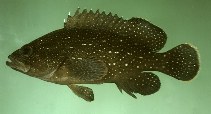http://www.fishbase.org/Summary/speciesSummary.php?genusname=Epinephelus&speciesname=polystigma ---> http://192.134.151.83/Summary/speciesSummary.php?genusname=Epinephelus&speciesname=polystigma
http://192.134.151.83/Summary/speciesSummary.php?genusname=Epinephelus&speciesname=polystigma ---> https://fishbase.mnhn.fr/Summary/speciesSummary.php?genusname=Epinephelus&speciesname=polystigma
https://fishbase.mnhn.fr/Summary/speciesSummary.php?genusname=Epinephelus&speciesname=polystigma ---> https://fishbase.mnhn.fr/summary/Epinephelus-polystigma.html
Epinephelus polystigma, White-dotted grouper : fisheries

You can
sponsor
this page
Common name (e.g. trout)
Genus + Species (e.g. Gadus morhua)
-

-
About this page
-
Languages
-
User feedbacks
-
Citation
-
Uploads
-
Related species
-


 White-dotted grouper
Upload your
photos
and
videos
White-dotted grouper
Upload your
photos
and
videos
Pictures
|
Google image
 Epinephelus polystigma
Epinephelus polystigma
Picture by
Randall, J.E.
Teleostei (teleosts) >
Perciformes/Serranoidei
(Groupers) >
Epinephelidae
(Groupers)
Etymology:
Epinephelus:
Greek, epinephelos = cloudy (Ref.
45335
)
.
More on author:
Bleeker
.
Environment: milieu / climate zone / depth range / distribution range
Ecology
Freshwater; brackish; demersal. Tropical; 20°N - 16°S, 99°E - 164°E (Ref.
5222
)
Asia and Oceania: Andaman Is., Indonesia, Philippines, Papua New Guinea, New Ireland, Australia and the Solomon Islands.
Size / Weight / Age
Maturity: L
m
?
range ? - ? cm
Max length : 48.0 cm TL male/unsexed; (Ref.
89707
)
Dorsal
spines
(total): 11;
Dorsal
soft rays
(total): 15-16;
Anal
spines
: 3;
Anal
soft rays
: 8. Distinguished by the following characteristics: dark brown to nearly blackish color; fins with small white to yellowish-white dots; weakly ctenoid scales on body except cycloid anteriorly above lateral line, on thorax and abdomen; body with auxiliary scales; greatest depth of body 2.6-3.0 in SL; rounded caudal fin; pelvic fins, 1.9-2.2 in head length (Ref.
90102
); head length 2.3-2.7 times in SL; flat interorbital area; short snout, length subequal to eye diameter; preorbital depth less than greatest width of upper lip; rounded preopercle, finely serrate, serrae at angle slightly enlarged; upper edge of operculum mostly enlarged; funnel-shaped anterior nostrils, rear margin expanded as a flap reaching posterior nostril; posterior nostril diameter 2-4 times larger than anterior nostril diameter; maxilla reaches past vertical at rear edge of eye, lower edge with rounded step at front of widest part; 2-3 rows of small subequal teeth on midlateral part of lower jaw; presence of 2 short stout canines at front of both jaws; pyloric caeca 8 (Ref.
89707
).
Found in estuaries (Ref.
75154
). Usual habitat seems to be mangrove areas (Ref.
5222
). Benthic (Ref.
75154
). Forms large aggregations in shallow waters of river mouths and brackish mangrove regions throughout the year, prior to new moon (Ref.
89707
).
Life cycle and mating behavior
Maturity
|
Reproduction
|
Spawning
|
Eggs
|
Fecundity
|
Larvae
Heemstra, P.C. and J.E. Randall
, 1993. FAO Species Catalogue. Vol. 16. Groupers of the world (family Serranidae, subfamily Epinephelinae). An annotated and illustrated catalogue of the grouper, rockcod, hind, coral grouper and lyretail species known to date. Rome: FAO. FAO Fish. Synop. 125(16):382 p. (Ref.
5222
)
IUCN Red List Status (Ref.
130435
)
Least Concern (LC)
; Date assessed:
22 November 2016
CITES
Not Evaluated
Not Evaluated
Threat to humans
Harmless
Human uses
Fisheries: subsistence fisheries
FAO - Publication:
search
|
FishSource
|
More information
Countries
FAO areas
Ecosystems
Occurrences
Introductions
Stocks
Ecology
Diet
Food items
Food consumption
Ration
Common names
Synonyms
Metabolism
Predators
Ecotoxicology
Reproduction
Maturity
Spawning
Spawning aggregation
Fecundity
Eggs
Egg development
Age/Size
Growth
Length-weight
Length-length
Length-frequencies
Morphometrics
Morphology
Larvae
Larval dynamics
Recruitment
Abundance
BRUVS
References
Aquaculture
Aquaculture profile
Strains
Genetics
Electrophoreses
Heritability
Diseases
Processing
Nutrients
Mass conversion
Collaborators
Pictures
Stamps, Coins Misc.
Sounds
Ciguatera
Speed
Swim. type
Gill area
Otoliths
Brains
Vision
Tools
E-book
|
Field guide
|
Identification keys
|
Length-frequency wizard
|
Life-history tool
|
Point map
|
Classification Tree
|
Catch-MSY
|
Special reports
Check for Aquarium maintenance
|
Check for Species Fact Sheets
|
Check for Aquaculture Fact Sheets
Download XML
Summary page
|
Point data
|
Common names
|
Photos
Internet sources
AFORO (otoliths) |
Aquatic Commons
|
BHL
|
Cloffa
|
BOLDSystems
|
Websites from users
|
Check FishWatcher
|
CISTI
|
Catalog of Fishes
:
genus
,
species
|
DiscoverLife
|
ECOTOX
| FAO - Publication:
search
|
Faunafri
| Fishipedia |
Fishtrace
| GenBank:
genome
,
nucleotide
|
GloBI
|
Google Books
|
Google Scholar
|
Google
| IGFA World Record |
MitoFish
|
Otolith Atlas of Taiwan Fishes
|
PubMed
| Reef Life Survey | Socotra Atlas |
Tree of Life
| Wikipedia:
Go
,
Search
| World Records Freshwater Fishing |
Zoological Record
Estimates based on models
Phylogenetic diversity index (Ref.
82804
): PD
50
= 0.5000 [Uniqueness, from 0.5 = low to 2.0 = high].
Bayesian length-weight: a=0.01175 (0.00571 - 0.02419), b=3.04 (2.88 - 3.20), in cm total length, based on LWR estimates for this Genus-body shape (Ref.
93245
).
Trophic level (Ref.
69278
): 3.8 ±0.5 se; based on size and trophs of closest relatives
Resilience (Ref.
120179
): Medium, minimum population doubling time 1.4 - 4.4 years (Preliminary K or Fecundity.).
Fishing Vulnerability (Ref.
59153
): Moderate vulnerability (38 of 100).
Price category (Ref.
80766
):
Very high
.
Back to Search
Random Species
Back to Top
Accessed through:
Not available
FishBase mirror site :
localhost
Page last modified by :
mrius-barile
- 20 July 2016
Fatal error
: Uncaught ArgumentCountError: Too few arguments to function checkEcotox(), 1 passed in /var/www/html/summary/speciessummary.php on line 2304 and exactly 3 expected in /var/www/html/includes/speciessummary.lib.php:2579 Stack trace: #0 /var/www/html/summary/speciessummary.php(2304): checkEcotox() #1 {main} thrown in
/var/www/html/includes/speciessummary.lib.php
on line
2579
|